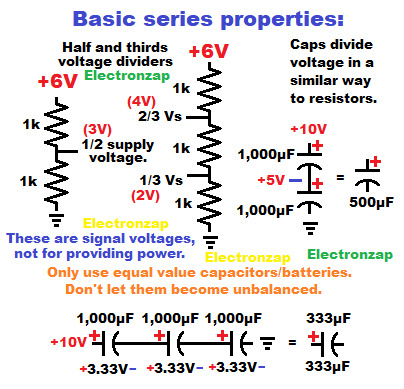Table of Contents
Series capacitors have the basic properties of…

Capacitor kit affiliate link ad.
- Being able to be charged to a higher voltage than their individually rated values
- Providing less capacitance than their individually rated values.
You must take care that series capacitors stay balanced (at the same voltage of each other).
Series capacitors divide up supply voltage in a similar way to series resistors. Each one of them only charges to a fraction of the total voltage applied to them. Therefore, series capacitors can be charged to a higher total voltage than the limit of just one of them.
- All of the series capacitors should have the same capacitance. Otherwise they will become unbalanced. Even if they have the same capacitance, they might become unbalanced.
The same current travels through each series capacitor. Therefore, all of them charge based on the current flow and their capacitance. Since the voltages add up, that means that it takes less current to change the total voltage than a lone capacitor of the value that they are. That is why series capacitors have less capacitance than a lone capacitor of the same value as one of them.
Video:
Supercapacitors commonly come with a 2.7V maximum voltage that they can be charged to.
- 4 series 2.7V supercapacitors can be charged up to 10.8V.
- 6 series 2.7V supercapacitors can be charged up to 16.2V.
This assumes that they all stay balanced (at the same voltage).
Not fully charging and discharging helps keep each of the individual series supercapacitors from over charging (above it’s maximum rated voltage) or reverse charging.
- If any capacitor falls to zero volts, then it will be reverse charged by any series capacitor(s) with a higher voltage, if they continue to discharge.
- Almost all supercapacitors are polarized. They can only be charged in one direction. Reverse charging will probably damage it. It may even explode.
- If supercapacitors are unbalanced, then an average voltage of 2.7V for series supercapacitors will mean that one or more of them is actually above that voltage. While at the same time, one or more of them are below that voltage.
To support this site, check out the following links:
Art of electronics is easily my favorite learning electronics book. It helps to already be familiar with basic electronics while studying it. It inspires many of my demonstration circuits. An affiliate link ad that supports this site.
- Become a Patron!
- Check out my YouTube videos! https://www.youtube.com/c/Electronzap/videos
- Products I used in my videos or otherwise think look like a good buy. As an Amazon associate, I earn from qualifying purchases. https://www.amazon.com/shop/electronzapdotcom
This is a new page that will be updated soon!
- Information on this site is not guaranteed to be accurate. Always consult the manufacturer info/datasheet of parts you use. Research the proper safety precautions for everything you do.
- Electronzap is a participant in the Amazon Services LLC Associates Program, an affiliate advertising program designed to provide a means for sites to earn advertising fees by advertising and linking to amazon.com.